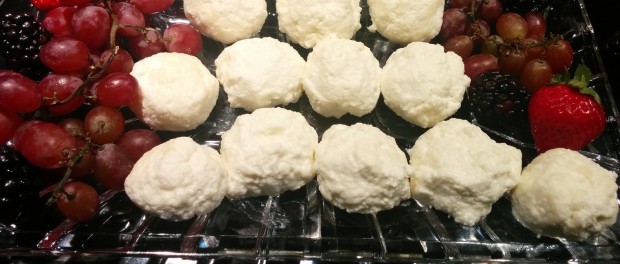40 and Famished: U-Main Cheese Making Kit
I bought a cheese cookbook about 17 years ago. I never made one recipe due to 1) lack of ingredients 2) lack of time. A few decades later, along comes U-Main and problem number one is solved.
U-Main founders Pascale and Max have made it their mission to “to re-humanize our relationship to food by involving our own hands in its production, transforming this fundamental part of our lives in a more natural and satisfying element.” They also solved my 17-year dilemma by assembling a cheese making kit that provides you with everything you need to make a small batch of artisanal cheese.
No really, I challenge you to reach back into time: It is 1998 and you’re thinking “Where can I get some renet and lipase to make me some curds?” Yep, Google didn’t exist. Some semblance of a search engine may have led you to some cheese making quakery, but I’m willing to wager you a 10-year-old aged cheddar that you weren’t able to locate bottled or even artificial enzymes to add to your pasteurized milk.
U-Main kits come fully equipped to make your first batch of cheese: a cheese thermometer, cheese strainer, cheese cloth, citric acid, cheese salt, and the essential rennet and lipase and four recipes with step-by-step instructions. You can make up to four batches of cheese with this kit but you will need to run out to Dollarama and get some more cheesecloth. Imagine my excitement — I was actually going to use cheesecloth… to make actual cheese and not to strain my chicken stock!!!
It is a labour intensive process and you need to leave 1.5-2.5 hours free to do this, at least your first time. It is recommended that you start with an easier cheese like Queso Blanco or Ricotta. I however had a secret weapon: my husband worked in a cheese factory for 7 years so I was pretty sure this was going to be a cinch!
https://vimeo.com/136455881
U-Main has a short video to walk you through the Mozzarella process. We watched it twice, then began the chemistry lab. Cheese making really is more of a science than an art, until you have mastered taking readings from a cheese thermometer, preparing your hot water steam bath and figured out how to separate your milk solids from the liquid without agitating it too much.
Mozzarella attempt number one didn’t quite fail so much as it did succeed in making delicious Ricotta! When you heat your milk to 42C, it really means 42, and going higher than that has its unfortunate consequences.
Take two: return to Vimeo and stream video twice more. Begin warming milk, take measurements in SEVERAL different spots in your pan. During error number 2, we discovered that the thermometer needs to be pierced down into the liquid and down to the same depths whenever you move the tool. The milk heats higher at the bottom than the top.
Despite over heating the second time, this batch more closely resembled Mozzarella. We chose to roll them into balls like Pascale demonstrates. Mine didn’t have the smooth texture and resembled matzo balls more than cheese, but the texture was chewy, though the flavour had more of a feta quality to it.
By the way, what is lipase? Lipase (pronounced lie-paze) is one of at least 60 enzymes living in milk. The exact amount of lipase in the milk depends on the breed of animal and their diet. Lipase enzymes function is to attack the fat globules and break them down. This releases free fatty acids. When this happens the way it is supposed to, during the ripening, it gradually increases the “picante” flavor of the cheese. It also makes the texture smooth and velvety. And did you also know that some bacteria thrive in refrigerator temperatures? They are called psychrotrophic bacteria. That would definitely explain the weird post-cheese consuming dreams I had last night.
U-Main kits make a great holiday present to gift someone while they are on vacation and have more time to commit to fun, food-related activities.
Thank you U-Main, for debunking the mystery of cheese making. I have gotten over my phobia of rennet and am more familiar with heating milk without boiling it. I look forward to adding different ingredients to my cheeses and experimenting more. Now if they could solve the problem of the limited 24 hour day, it would be a dream come true.

4. Guage the heat and watch the elements separate. U Main cheese making. Mozzarella. Photo Esther Szeben.
Please visit U-Main to learn where you can buy U-Main Cheese Making kits. Join their Facebook group to share in the cheese making dialog. U-Main regularly appears at holiday bazaars in Montreal selling the kits, or order online. They also have an etsy site. A mini kit costs just $8.50 and makes 1.6 kg of cheese. Other kits that make 8 kg of cheese or more cost $24.50 and up.












